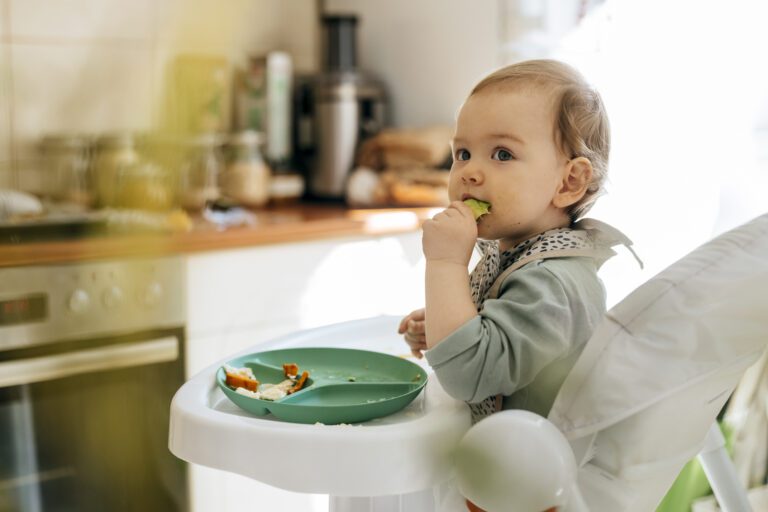Great job, mamas! You’ve hit a new milestone, and now it’s time to start feeding solids to your little one. Introducing your baby to the world of whole foods can be an exciting and overwhelming experience. Let’s take a deep dive into the when, what, why, and how of first foods!
When to Introduce Foods?
You may feel anxious to give solid foods to your baby when they start showing signs of interest around five to six months. Until now, baby’s diet has consisted solely of breastmilk or formula. Use this short safety checklist to consider if your baby is ready to start solids:
- Sits up independently
- Holds up their own head and neck
- Swallows food instead of pushing it back out of their mouth
- Grasps objects
- Opens mouth when others are eating
Many babies can do all or most of these things by six months of age. If you think your baby is ready for first foods before six months, talk with your pediatric care provider.
What Are The Best First Foods and Why?
Most pediatricians, nutritionists, and dieticians would agree that the best first foods are high in iron and rich in nutrients.
Why is that? Babies are born with large iron stores that last about 4 to 6 months. Introducing solid foods is recommended just as baby has used up their iron stores for growth and development. It’s then vital that baby is getting enough dietary iron to support their fast-paced growth and reduce the risk of iron-deficiency anemia. Breastfed babies are at a higher risk of iron deficiency anemia because breastmilk is low in iron.
High-iron First Foods
A common first food choice is an iron-fortified rice or oatmeal cereal fed to baby with a spoon, not in their bottle. Here are some other great high-iron first foods to consider:
- Lamb, beef, goat, or venison
- Beef liver pureed
- Chicken and pork
- Egg yolks
- Shellfish
- Beans and lentils
- Green veggies like broccoli and string beans
How to Introduce the First Foods?
The American Academy of Pediatrics has set a few guidelines for experimenting with the best first foods:
- Expose your baby to a variety of tastes and textures.
- Be prepared as your baby may cough, gag, or spit up as they learn to navigate the new foods in their mouth
- Try foods one at a time
- Wait 3 to 5 days between new foods to see if there is any negative reaction
- Introduce foods multiple times
- Select initial offerings that can lead to healthy food choices in the future
- Make your own baby food designed to baby’s liking
What About Allergens?
Food allergies are on the rise and are a concern for every parent. Studies have shown that introducing traditionally allergenic foods early and often may decrease the chance of developing allergic reactions. Common allergens include cow’s milk, eggs, fish, shellfish, tree nuts, peanuts, wheat, soy, and sesame. Drinking cow’s milk is not recommended before 12 months of age, but other products, such as yogurt and cheese, can be started earlier.
Baby Feeding Methods
Who would have thought that baby feeding methods were a thing? You may encounter many opinions on baby feeding techniques. The two most common are:
- Pureed baby food gives a smooth and soft consistency. You can then feed baby with a spoon and keep track of the amount baby is eating.
- Baby-led weaning allows baby to feed themselves. Finger foods are large enough to be grasped, soft, and easily mashed in the mouth. This is considered a baby-directed method.
Regardless of how you’d like to feed your baby, the first food options are incredibly similar, with a different presentation. There’s no wrong way to feed your baby. Nor do you have to choose only one method! Every baby, parent, and family situation is different.
Babies eat small amounts of food, and every bite should count! Optimal nutrition is essential for growth and development. Introducing your baby to the wonderful world of food should be fun, intuitive, and, of course, messy!
YOU MAY ALSO LIKE: DIY Baby Food: Economical, Easy and Nutritious






Comments are closed.